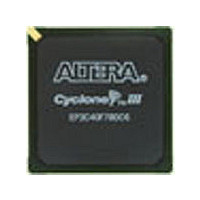EP3C5E144A7N Altera, EP3C5E144A7N Datasheet - Page 107

EP3C5E144A7N
Manufacturer Part Number
EP3C5E144A7N
Description
Cyclone III
Manufacturer
Altera
Datasheet
1.EP3C5E144A7N.pdf
(274 pages)
Specifications of EP3C5E144A7N
Family Name
Cyclone III
Number Of Logic Blocks/elements
5136
# I/os (max)
94
Frequency (max)
437.5MHz
Process Technology
65nm
Operating Supply Voltage (typ)
1.2V
Logic Cells
5136
Ram Bits
423936
Operating Supply Voltage (min)
1.15V
Operating Supply Voltage (max)
1.25V
Operating Temp Range
-40C to 125C
Operating Temperature Classification
Automotive
Mounting
Surface Mount
Pin Count
144
Package Type
EQFP
Lead Free Status / Rohs Status
Compliant
Available stocks
Company
Part Number
Manufacturer
Quantity
Price
- Current page: 107 of 274
- Download datasheet (6Mb)
Chapter 6: I/O Features in the Cyclone III Device Family
OCT Support
LVDS Transmitter Programmable Pre-Emphasis
OCT Support
Table 6–3. Selectable I/O Drivers for On-Chip Series Termination with and Without Calibration Setting (Part 1 of 2)
© December 2009
3.0-V LVTTL/LVCMOS
2.5-V LVTTL/LVCMOS
1.8-V LVTTL/LVCMOS
1.5-V LVCMOS
1.2-V LVCMOS
SSTL-2 Class I
SSTL-2 Class II
I/O Standard
f
1
Altera Corporation
The Cyclone III device family true LVDS transmitter supports programmable
pre-emphasis. Programmable pre-emphasis is used to compensate the
frequency-dependent attenuation of the transmission line. It increases the amplitude
of the high-frequency components of the output signal, which cancels out much of the
high-frequency loss of the transmission line.
The Quartus II software allows two settings for programmable pre-emphasis
control—0 and 1, in which 0 is pre-emphasis off and 1 is pre-emphasis on. The default
setting is 1. The amount of pre-emphasis needed depends on the amplification of the
high-frequency components along the transmission line. You must adjust the setting
to suit your designs, as pre-emphasis decreases the amplitude of the low-frequency
component of the output signal as well.
For more information about the Cyclone III device family high-speed differential
interface support, refer to the
chapter.
The Cyclone III device family features OCT to provide I/O impedance matching and
termination capabilities. OCT helps to prevent reflections and maintain signal
integrity while minimizing the need for external resistors in high pin-count ball grid
array (BGA) packages. The Cyclone III device family provides I/O driver on-chip
impedance matching and on-chip series termination for single-ended outputs and
bidirectional pins.
When using on-chip series termination, programmable current strength is not
available.
There are two ways to implement OCT in the Cyclone III device family:
■
■
Table 6–3
termination.
On-Chip Series Termination with Calibration
OCT with calibration
OCT without calibration
Row I/O
50, 25
50, 25
50, 25
50, 25
lists the I/O standards that support impedance matching and series
50
50
25
Setting, in ohms (Ω)
Column I/O
50, 25
50, 25
50, 25
50, 25
50, 25
High-Speed Differential Interfaces in Cyclone III Devices
50
25
On-Chip Series Termination Without Calibration
Row I/O
50, 25
50, 25
50, 25
50, 25
50
50
25
Setting, in ohms (Ω)
Cyclone III Device Handbook, Volume 1
Column I/O
50, 25
50, 25
50, 25
50, 25
50, 25
50
25
6–7
Related parts for EP3C5E144A7N
Image
Part Number
Description
Manufacturer
Datasheet
Request
R

Part Number:
Description:
Cyclone III Device Data Sheet
Manufacturer:
ALTERA [Altera Corporation]
Datasheet:

Part Number:
Description:
CYCLONE II STARTER KIT EP2C20N
Manufacturer:
Altera
Datasheet:

Part Number:
Description:
CPLD, EP610 Family, ECMOS Process, 300 Gates, 16 Macro Cells, 16 Reg., 16 User I/Os, 5V Supply, 35 Speed Grade, 24DIP
Manufacturer:
Altera Corporation
Datasheet:

Part Number:
Description:
CPLD, EP610 Family, ECMOS Process, 300 Gates, 16 Macro Cells, 16 Reg., 16 User I/Os, 5V Supply, 15 Speed Grade, 24DIP
Manufacturer:
Altera Corporation
Datasheet:

Part Number:
Description:
Manufacturer:
Altera Corporation
Datasheet:

Part Number:
Description:
CPLD, EP610 Family, ECMOS Process, 300 Gates, 16 Macro Cells, 16 Reg., 16 User I/Os, 5V Supply, 30 Speed Grade, 24DIP
Manufacturer:
Altera Corporation
Datasheet:

Part Number:
Description:
High-performance, low-power erasable programmable logic devices with 8 macrocells, 10ns
Manufacturer:
Altera Corporation
Datasheet:

Part Number:
Description:
High-performance, low-power erasable programmable logic devices with 8 macrocells, 7ns
Manufacturer:
Altera Corporation
Datasheet:

Part Number:
Description:
Classic EPLD
Manufacturer:
Altera Corporation
Datasheet:

Part Number:
Description:
High-performance, low-power erasable programmable logic devices with 8 macrocells, 10ns
Manufacturer:
Altera Corporation
Datasheet:

Part Number:
Description:
Manufacturer:
Altera Corporation
Datasheet:

Part Number:
Description:
Manufacturer:
Altera Corporation
Datasheet:

Part Number:
Description:
Manufacturer:
Altera Corporation
Datasheet:












